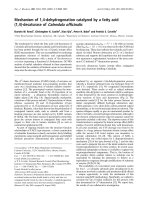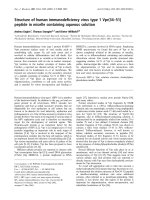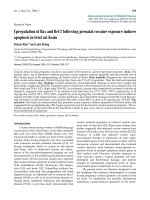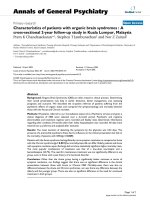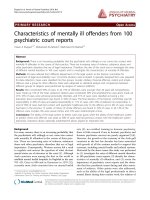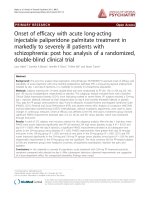Báo cáo y học: "Characteristics of patients with organic brain syndromes : A cross-sectional 2-year follow-up study in Kuala Lumpur, Malaysia" pps
Bạn đang xem bản rút gọn của tài liệu. Xem và tải ngay bản đầy đủ của tài liệu tại đây (255.44 KB, 7 trang )
BioMed Central
Page 1 of 7
(page number not for citation purposes)
Annals of General Psychiatry
Open Access
Primary research
Characteristics of patients with organic brain syndromes : A
cross-sectional 2-year follow-up study in Kuala Lumpur, Malaysia
Prem K Chandrasekaran*
1
, Stephen T Jambunathan
2
and Nor Z Zainal
2
Address:
1
NeuroBehavioural Medicine, Penang Adventist Hospital, Penang, Malaysia and
2
Department of Psychological Medicine, University of
Malaya Medical Centre, Kuala Lumpur, Malaysia
Email: Prem K Chandrasekaran* - ; Stephen T Jambunathan - ;
Nor Z Zainal -
* Corresponding author
Abstract
Background: Organic Brain Syndromes (OBS) are often missed in clinical practice. Determining
their varied presentations may help in earlier detection, better management, and, assessing
prognosis and outcome. We described the in-patient referrals of patients suffering from the
psychiatric effects of organic states and compared the symptomatology and mortality between
those with the Acute and Chronic varieties.
Methods: 59 patients referred to our Consultation-Liaison (C-L) Psychiatry services and given a
clinical diagnosis of OBS were selected over a 6-month period. Psychiatric and cognitive
abnormalities and treatment regimes were recorded and fatality rates determined. Information
regarding their condition 24 months after their index hospitalization was recorded. All data were
entered into a proforma and analyzed after exclusion.
Results: The mean duration of detecting the symptoms by the physician was 3.52 days. The
presence of a premorbid psychiatric illness had no influence on the clinical presentation but did on
the mortality of patients with OBS (p = 0.029).
Patients with the Acute syndrome had significantly more symptom resolution as compared to those
with the Chronic syndrome (p = 0.001) but mortalityrates did not differ. Elderly patients and those
with symptom resolution upon discharge did not show statistically significant higher mortality rates.
The most popular combination of treatment was that of a low-dose neuroleptic and a
benzodiazepine (34.7%). The need for maintenance treatment was not significantly different in any
group, even in those with a past history of a functional disorder.
Conclusion: Other than the Acute group having a significantly better outcome in terms of
symptom resolution, our findings suggest that there was no significant difference in the clinical
presentation between those with Acute or Chronic OBS. Mortality-wise, there was also no
difference between the Acute and Chronic syndromes, nor was there any difference between the
elderly and the younger group. There was also no significant difference in the need for continued
treatment in both groups.
Published: 15 April 2005
Annals of General Psychiatry 2005, 4:9 doi:10.1186/1744-859X-4-9
Received: 11 February 2004
Accepted: 15 April 2005
This article is available from: />© 2005 Chandrasekaran et al; licensee BioMed Central Ltd.
This is an Open Access article distributed under the terms of the Creative Commons Attribution License ( />),
which permits unrestricted use, distribution, and reproduction in any medium, provided the original work is properly cited.
Annals of General Psychiatry 2005, 4:9 />Page 2 of 7
(page number not for citation purposes)
Background
Diseases of the brain are frequently manifested by psychi-
atric symptomatology, a condition conventionally termed
'Organic Brain Syndrome'. Given the complexity of the
nervous system and the vast range of pathological proc-
esses that can affect it, a broader view that there exist a
number of different and distinct organic brain syndromes
seems more likely. OBS is not a specific neurological diag-
nosis although it remains a standard diagnostic category.
One justification for the use of the term is as a kind of
abbreviated phrase to refer to the full range of abnormal
mental symptoms commonly associated with definable
neurological disease [1]. It should be stressed that OBS are
defined in psychiatric terms and not in neurologic terms.
They are purely descriptive and carry no specific aetiologic
implications [2]. Considering the variety of pathological
processes that fall under this heading, it is not surprising
that no one particular agent has proven to be of significant
benefit to date [1]. Symptoms suggestive of cognitive
impairment may even persist in a proportion of cases long
after the initial episode, especially when the cerebral
insult is irreversible [3]. The aims of this study were:
(1) to measure the efficiency of medical personnel in
detecting patients suffering from the psychiatric effects of
organic states,
(2) to compare the various patterns of clinical presenta-
tion between those with the Acute and Chronic varieties
of OBS,
(3) to assess the mortality of these neuropsychiatric epi-
sodes after a 2 year period, and,
(4) to determine the various ways psychotropic medica-
tions were used
Methods
Sample
A total of 196 patients were referred to the C-L Psychiatry
services of the Department of Psychological Medicine,
University of Malaya Medical Centre (UMMC) between
1
st
March and 30
th
September, 1998. Of this number, 59
patients were diagnosed to have OBS and this sample con-
stituted the focus of this study. Being a cross-sectional fol-
low-up study, the 3 patients whose case notes were not
traceable were excluded from the sample.
Materials
The data were collected from the referral records and fur-
ther information was obtained from the patient's case
notes. Based on the case notes, all cases were assessed dur-
ing the index admission by a Trainee Psychiatrist, the Prin-
cipal Investigator (PI i.e. author PK), and a Consultant
Psychiatrist within 3 hours of receiving the referral form.
Patients who were diagnosed to have Acute or Chronic
OBS were selected for this study. Their demographic data,
psychiatric history (which included clinical presentation
and premorbid personality), medical history, mental sta-
tus examination, physical examination, laboratory inves-
tigations, treatment and the progress, in terms of
symptom resolution, were recorded. The data were used
for specific sub-diagnoses according to the Diagnostic and
Statistical Manual of Mental Disorders – 4
th
Edition
(DSM-4) [4] and the fatality rates were determined.
Determining the number of days that elapsed from the
onset of symptoms to the time the C-L referral was made
gave a crude assessment of efficiency of medical personnel
in detecting OBS. The case notes were examined further to
see the follow-up progress of patients after 2 years. The PI
then called the patients who had defaulted follow-up for
enquiries about their condition and treatment. All data
entered into the proforma was validated by the Lecturer
involved, the Second Investigator (author ST).
Statistical analysis
With the Consultant involved, the Third Investigator
(author NZ), overseeing the progress, the data were ana-
lyzed using the Statistical Package for the Social Sciences
(SPSS) 7.5. Descriptive statistics were presented as mean
plus or minus standard deviation (SD) and the differences
between groups were assessed by the independent sam-
ples t-test for equality of means (2-tailed).
Categorical data were analyzed using the Pearson's Chi-
square test (2-sided) for differences between the Acute
and Chronic groups or the Fisher's exact test (2-sided),
where appropriate. The level of significance is p = < 0.05.
Results
A. Demographic data
44 of the total number of patients were below the age of
65 (78.6%) and 12 were above 65 (21.4%). 37 were male
(66.1%) and 19 were female (33.9%).
B. Descriptive data
1) Duration of symptoms before referral
The minimum number of days elapsed from onset of
symptoms to the C-L referral was 0 days and the maxi-
mum was 16 days. The mean value was 3.52 days and the
SD was 3.29.
2) Underlying psychiatric disorder
Listed below are 17 of the 49 patients who had premorbid
psychiatric illnesses and all of them with functional diag-
noses were in remission at the time of this study.
• Alzheimer's dementia – 5
Annals of General Psychiatry 2005, 4:9 />Page 3 of 7
(page number not for citation purposes)
• Major depression – 3
• Alcoholic dementia – 2
• Post-ictal psychosis – 1
• Alcoholic hallucinosis – 1
• Mental retardation with Bipolar affective disorder – 1
• Post-concussional dementia – 1
• Brief reactive psychosis – 1
• SLE-induced psychosis – 1
• Simple deteriorative disorder – 1
3) Perceptual disturbances and thought disorder
17 of the patients (30.4%) experienced visual hallucina-
tions, 15 (26.8%) of them had auditory hallucinations
and only 12 (21.4%) were deluded.
4) Cognitive functions
17 patients had global disorientation to time, place and
person. Furthermore, all those disorientated had disorien-
tation to time. All patients had impairment of attention
and concentration (Table 1).
5) Liaison psychiatry diagnosis
A clear organic triggering factor could be found for all
patients. 49 (87.5%) of them had Acute OBS and only 7
(12.5%) had the Chronic variety. The respective coded
DSM-4 diagnoses, with specific coding, were given (Table
2).
6) Psychiatric treatment
Only 2 did not require psychiatric treatment and they
were those with vascular dementia and morphine intoxi-
cation delirium. Of the 54 that required it, 21 of them
required relatively high doses i.e. 12 with delirious states,
including all 5 alcohol withdrawals, 2 with vascular
dementias, 1 with the organic psychotic disorder and 1
with the organic mood syndrome. 3 of them had a previ-
ous history of a mental illness. Only 9 of them were agi-
tated. 32 of the 49 (65.3%) with acute syndromes
required relatively low doses of medication. 27 of the 33
(81.8%) that required low doses were in a delirium (Fig-
ure 1).
Table 1: Cognitive functions
Disorientation to: Frequency %
Time 48 85.7
Place 25 44.6
Person 23 41.1
Impairment of: Frequency %
Recent memory 54 96.4
Remote memory 41 73.2
Attention and concentration 56 100.0
Table 2: Liaison psychiatry diagnosis
Acute:
293.0 – There were 44 with delirium due to various causes:
• Head trauma – 6
• Uremia – 4
• Post-ictal state – 4
• Post-operative state – 2
• Brain metastasis – 2
• Hyperglycaemia – 2
• Burn trauma – 2
• Anaemia – 2
• Cerebral infarction – 2 (1 with alcohol-induced persisting dementia
– 291.2)
• Hepatic encephalopathy – 1
• Septicaemia – 1
• Multiple myeloma – 1
• Cerebral lupus – 1
• Cerebral hypoxia – 1
• Hyponatremia – 1 (with co-existing thyrotoxicosis)
291.0 – Alcohol withdrawal delirium – 6 (1 with co-existing delirium
due to hypoglycaemia – 293.0)
292.81 – Steroid-withdrawal delirium – 2
290.11 – Dementia of Alzheimer's type, early onset, with delirium
due to post- operative state – 1
290.11 – Dementia of Alzheimer's type, early onset, with delirium
due to non- convulsive status – 1
290.3 – Dementia of Alzheimer's type, late onset, with delirium due
to carcinoma – 1
292.81 – Opioid intoxication delirium – 1
293.81 – Psychotic disorder due to Cushing's disease, with delusions
– 1
293.82 – Psychotic disorder due to end stage renal failure – 1
293.83 – Mood disorder due to acute myocardial infarction – 1
293.83 – Mood disorder due to post-operative state – 1
293.83 – Mood disorder due to cerebral lupus – 1
Chronic:
290.40 – Uncomplicated vascular dementia – 2
290.42 – Vascular dementia with delusions – 1
290.43 – Vascular dementia with depressed mood – 1
290.20 – Dementia of Alzheimer's type, late onset, with delusions – 1
290.0 – Dementia of Alzheimer's type, late onset, uncomplicated – 1
294.0 – Alcohol-induced amnestic disorder, chronic – 1
Annals of General Psychiatry 2005, 4:9 />Page 4 of 7
(page number not for citation purposes)
7) Total symptom resolution (upon discharge)
34 (60.7%) of the total had symptom resolution on dis-
charge and 22 of them (39.3%) did not. Below is the
breakdown of symptom resolution for the specific
subgroups.
• Delirium – 33 of the 45 (73.3%) had total symptom
resolution
• Dementia – 5 of the 10 (50.0%) with dementia had no
symptom resolution
• Organic psychotic disorder – 1 with post-ictal state and
1 with Cushing's disease had symptom resolution
• Organic mood syndrome – only the 1 with post-opera-
tive state recovered
• Transient amnestic disorder – the 1 with this disorder
had total resolution of symptoms
8) Mortality
19 of these patients (33.9%) had passed away during the
2-year period and another 19 had defaulted follow-up.
There were only 18 (33.9%) alive at the end of this study.
9) Continuing treatment
At the end of this study period, of the 18 that could be
traced, 14 were not on treatment and of the 4 who were
still on treatment, 1 of them was in the Chronic group –
vascular dementia – and 3 in the Acute group – cerebral
hypoxic delirium, organic psychotic disorder and organic
mood syndrome. 3 of them had a past history of a mental
disorder and all of them were on Chlorpromazine, Thior-
idazine, Sulpiride or Risperidone. 3 had been on
Haloperidol and 1 on Mianserin during the index
admission.
C. Difference in clinical presentation between those with
the Acute and Chronic varieties
None of these analyses proved to be of any significance.
D. Influence of previous psychiatric history on
hallucinations and delusions in OBS
Again, none of these associations proved significant.
Cross-tabulations reported p = 0.919, p = 0.770, p = 0.336
respectively for visual hallucinations, auditory hallucina-
tions and delusions.
E. Association between psychiatric diagnosis and symptom
resolution upon discharge
Those patients with the Acute syndrome had significant
symptom resolution as compared with those having the
Chronic syndrome (p = 0.001). However, the elderly
patients had no significant decline towards symptom res-
olution as compared to the younger age group (p =
0.127).
F. Presence of previous psychiatric history and symptom
resolution upon discharge
In 1 patient with OBS and a history of a mental illness,
symptom resolution after commencing treatment was not
prolonged as indicated by an index of p = 0.167.
G. Effect of psychiatric diagnosis and mortality
There was no difference in terms of mortality between
those with the Acute or Chronic varieties of OBS. Even in
older patients with OBS, a value of p = 0.124 showed that
there was no significant difference in mortality as com-
pared to those younger than 65 years old.
H. The association between symptom resolution upon
discharge and mortality
There was no significant association between these 2
variables.
I. Influence of presence of previous psychiatric history in
those with OBS on mortality
This association proved to be of statistical significance (p
= 0.029) indicating that patients with a premorbid mental
disorder had lower mortality rates.
J. The need for continued treatment in the subgroups of
OBS
This was not significant (p = 0.405) showing that those
with the Chronic syndrome required no more
Psychiatric treatmentFigure 1
Psychiatric treatment. The category axis (y) represents
the types of treatment used and the value axis (x) represents
the frequency of use.
0
5
10
15
20
25
1
Types of treatment
Fre
q
uenc
y
of use
Ni l
Anti psychoti cs onl y
Anti depressants onl
y
Anxiolytics onl y
Ant i psychot i cs+Anxi
o
lytics
Annals of General Psychiatry 2005, 4:9 />Page 5 of 7
(page number not for citation purposes)
maintenance treatment as compared with the Acute
group. And in those with a previous psychiatric history,
the need for maintenance treatment was no different from
those without (p = 0.275). Even in the elderly patients,
there was no increased need for continued treatment, as
evidenced by a value of p = 0.405.
Discussion
Medical records provide a useful source of information
and diagnoses based on medical records are acceptable as
long as they are considered a substitute of diagnoses
obtained from a direct interview. Telephone interviewing
is also considered an acceptable alternative method and it
has been reported that comparable diagnostic informa-
tion is obtained through face-to-face and telephone inter-
views [5]. We had used both modalities to a certain extent
and they had their limitations, as would be discussed
later.
In this study, the geriatric group made up less than a quar-
ter of the sample, and on the whole, males predominated
the sample by two-thirds. The mean duration of time
elapsed from onset of symptoms in comparison with the
SD proved that detection of these syndromes has been
rather inefficient in this center (3.52 days). The associa-
tion between elapsed time and symptom resolution was
not significant. Although almost a third of them had a
previous history of a mental illness, it had no bearing on
the presence of hallucinations and delusions, nor did it on
symptom resolution or the need for continued treatment.
Those with the previous history did, however, require
higher doses of medication as compared to the rest
because of their underlying psychiatric illness. Oddly,
there were significantly lower mortality rates (p = 0.029)
in those who had a previous history of psychiatric disor-
der, possible reasons being that those cases may not have
been OBS in the first place but misdiagnosed instead, and
also the small number in that category. The above find-
ings suggest that premorbid functional disorders do not
affect the clinical presentation of patients during the
course of an OBS. However, since all the patients with pre-
morbid mental illnesses involved in the study were in
remission, the above suggestion cannot be concluded.
When there are severe perceptual disturbances in the vis-
ual modality, acute cerebral disorder is more implicated
than the chronic type [6]. Visual hallucinations predomi-
nated the clinical picture in contrast to auditory hallucina-
tions and delusions, but again did not vary in their
occurrence between both varieties of OBS. In a study by
Hirono [7], it was found that half of their patients with
Alzheimer's disease showed evidence of delusions or hal-
lucinations. Independent factors associated with psycho-
sis were older age, female sex, longer duration of illness
and more severe cognitive impairment. Orientation to
time is labile and quickly disrupted by organic causes. Ori-
entation to place is disturbed later in the disease process.
When established, disorientation to time and place are
evidence of an organic state and may be the earliest signs
in a dementing process. Disorientation to person occurs at
a very late stage. It was found that a very high number of
patients experienced disorientation to time and less than
half were disorientated to place and person. This points to
the early detection of these cases before their condition
deteriorated and produced global disorientation. Memory
disturbances associated with brain disease is referred as
organic or true amnesia and manifest as impairments of
registration, retention, retrieval, recall and recognition. In
organic states, attention may be profoundly decreased and
usually accompanied by lowering of consciousness [8].
Almost all patients had impairment of recent memory and
only just over a quarter of them had remote memory
impairment. Attention and concentration was, however,
impaired in all of them.
We tackled the confusion surrounding the Acute-Chronic
dichotomy by carrying on the initial diagnosis given by
the PI and Consultant Psychiatrist during the index
admission and going by the possible reversibility of a par-
ticular condition instead of the rapidity of its develop-
ment or resolution. Put simply, the primary cause of the
acute impairment is usually 'outside the brain' and that of
the chronic syndrome normally 'within the brain'. The
distinction between these two organic conditions is most
clearly derived from the history of the mode of onset of
the disorder. A short history and firm knowledge of an
acute onset will make a chronic reaction unlikely and
onset in association with a physical illness is strongly sug-
gestive of an acute organic reaction [6]. The use of specific
diagnoses is helpful as although most chronic organic dis-
orders cannot be reversed, a small number are potentially
treatable [9]. Acute disturbances of cerebral function may,
in time, progress to the development of irreversible struc-
tural pathology with an admixture of features specific to
both. The two may co-exist when a chronic dementing
process is complicated by another concomitant or super-
imposed disease [6]. Those with delirium superimposed
on dementia were designated as Acute as their symptoms
in their index admission were those of a delirious nature.
As expected, it was found that symptom resolution
occurred with significance in the Acute group as compared
to the Chronic group (p = 0.001). However, the younger
age group did not show any statistical significance toward
symptom resolution as compared to the older group.
Delirium has poor outcomes in hospitalized older
patients [10]. It has multiple aetiologies and a poor long-
term prognosis [11]. Advancing age increases the risk and
those over 60 years are at highest [12]. The older the
patient and the longer the delirium, the outcome is a
longer resolution of symptoms. A complete resolution of
Annals of General Psychiatry 2005, 4:9 />Page 6 of 7
(page number not for citation purposes)
confusional symptoms is not usually achievable in pro-
longed confusional states that are superimposed on
dementia. Improvement from severe to mild confusion or
merely a reduction of symptoms would be a more realistic
goal [13]. However, in this study, it was found that those
who had delirium on dementia had resolution of their
confusional symptoms. Even with treatment, there was no
improvement in their dementing features, as may be
expected.
It was found that there was no significant difference in
mortality rates between the Acute and Chronic groups,
possibly due to the small number of patients assigned to
the latter group. This was in keeping with observations
made by Inovye [14] that there were no significant associ-
ations between delirium and mortality and between delir-
ium and length of hospital stay. That study, however,
found delirium to be a significant predictor of functional
decline at both hospital discharge and at follow-up, there-
fore making it an important independent prognostic
determinant of hospitalization outcomes. Our findings
disagreed with the generally held concept that the occur-
rence of delirium was associated with a high mortality rate
in the following year, mainly because of the serious nature
of the provoking medical conditions. Even the mortality
in the elderly within the sample showed no statistical sig-
nificance as compared to those who were younger than 65
and the finding was not in keeping with related literature.
Huang [15] investigated the rate of delirium, reasons for
admission, clinical features, aetiologies and mortality dur-
ing a 2-year follow-up and found that the incidence of
delirium was higher in their geriatric group. However, the
older patients had a higher mortality rate during the 2-
year follow-up period and that stressed the importance of
after-discharge care in those patients. Higher death rates
have also been found among the cognitively impaired eld-
erly patients than those aged-matched patients with func-
tional psychiatric illnesses and the cognitively intact
elderly. Koponen[16] was of the same school of thought
and associated delirium with a significant rate of mortal-
ity. These results, however, were not in line with findings
by Rabins & Folstein [17] that cognitively impaired indi-
viduals have higher fatality rates than cognitively intact
individuals. There was also no significant association
between symptom resolution upon discharge during the
index admission and mortality.
As observed earlier, the most popularly used treatment in
our setting was a combination of a neuroleptic and a ben-
zodiazepine, usually Haloperidol and Lorazepam. This
combination accounted for the treatment of over a third
of patients and the use of a neuroleptic alone came sec-
ond, amounting to just under a third of the patients.
Adams [18] showed that parenteral Haloperidol offered
the first hope for treating delirium and the addition of
Lorazepam quickened the onset of sedation. Delirium is a
common component of dementia and may produce con-
siderable morbidity. In addition to psychotic features, it
may produce considerable agitation, which may be unre-
sponsive to conventional medications. The main
approach is to treat any underlying medical condition that
could cause the delirium. It is, however, not always revers-
ible and there is no specific treatment for persistent delir-
ium [19]. Cole, Primeau and Elie [20] found Haloperidol,
Chlorpromazine and Mianserin to be useful in control-
ling the symptoms of delirium and high levels of premor-
bid functioning were related to better outcomes. The use
of this selection of drugs was similarly practiced in our set-
ting although Chlorpromazine is now less widely used
and usually reserved more for its sedative-hypnotic effects.
This is because we have had experiences with its propen-
sity to lower the seizure threshold and to cause hypoten-
sion. Finally, there was no significant difference in the
need for continued treatment at 2 years in the Chronic
group as compared to the Acute group. Even in those with
a previous psychiatric history or in those who were in the
elderly age group, there appeared to be no difference.
Only 15 patients afflicted with these conditions were
compliant to follow-ups. There were only another 3 of
those who defaulted follow-up and whose conditions
were documented in their case notes when they were sub-
sequently admitted for other problems unrelated to that
of their index admission. Thus, there were still 19 of them
whose status at 2 years was unknown. The problem was
mainly with those having alcohol-related disorders and it
has been found that patients with alcohol delirium have
been known to have higher mortalities and have been
known to be more difficult to follow-up [16]. Of the 8
with these disorders, 2 had passed away, 4 were not con-
tactable and the 2 that were eventually contacted had not
turned up for follow-ups. This large number of dropouts
where follow-ups were concerned caused difficulties in
assessing the mortality rate after 2 years. It proves to be a
major issue in C-L Psychiatry and needs to be addressed to
ensure more comprehensive post-discharge care to this
group of patients.
Although the methods by which data were obtained in
this study have been validated previously [17], the ques-
tionable reliability of the data collected from the medical
records forms the first limitation. There was also little
information on the outcome of these patients in the
records and as earlier mentioned, telephone calls revealed
no new information. The second limitation was that
assessment scales had not been incorporated. Another
limitation to this study was the small sample size and con-
fined only to the UMMC thus, we were not able to apply
the results as representing a whole region. Also, the rela-
tively small number of patients with a diagnosis that
Publish with BioMed Central and every
scientist can read your work free of charge
"BioMed Central will be the most significant development for
disseminating the results of biomedical research in our lifetime."
Sir Paul Nurse, Cancer Research UK
Your research papers will be:
available free of charge to the entire biomedical community
peer reviewed and published immediately upon acceptance
cited in PubMed and archived on PubMed Central
yours — you keep the copyright
Submit your manuscript here:
/>BioMedcentral
Annals of General Psychiatry 2005, 4:9 />Page 7 of 7
(page number not for citation purposes)
suited the criteria for the Chronic syndrome had caused
difficulties in statistical analysis, as did the high rate of
dropouts on establishing the mortality rate after 2 years.
This study was intended to promote practical awareness
and possibly, improve the understanding and treatment,
of patients afflicted with organically-induced psychiatric
conditions. Its implications for clinical practice raise sev-
eral questions. We hope this report will stimulate renewed
interest in this field and although the findings do not con-
tribute to a new conceptual understanding of OBS, they
do suggest directions for further research on their
management.
References
1. Seltzer B, Sherwin L: "Organic Brain Syndromes": An Empirical
Study and Critical Review. Am J Psychiatry 1978, 135:1.
2. Lipowski ZJ: Organic Brain Syndromes: A Reformulation. Com-
prehensive Psychiatry 1978, 19(4):.
3. Deb S, Lyons I, Koutzoukis C: Neurobehavioural Symptoms 1-
Year After a Head Injury. Brit J Psychiat 1999, 174:360-365.
4. American Psychiatric Association: Diagnostic and Statistical Manual of
Mental Disorders 4th edition. Washington, DC: APA; 1994.
5. Stefanis CN, Dikeos DG, Papadimitriou GN: Clinical Strategies in
Genetic Research. Clinical Psychiatry – International Practice and
Research 1995, 1(1):.
6. Lishman WA: Organic Psychiatry – The Psychological Consequences of
Cerebral Disorder 3rd edition. Blackwell Science; 1998.
7. Hirono N: Factors Associated with Psychiatric Symptoms in
Alzheimer's Disease. J Neurol Neurosurg Psychiatry 1998,
64(5):648-652.
8. Sims A: Symptoms in the Mind – An Introduction to
DescriptivePsychopathology Bailliere Tindall; 1992.
9. Wells CE: Chronic Brain Disease: An Overview. Am J Psychiatry
1978, 135:1.
10. Inovye SK: A Multicomponent Intervention to Prevent Delir-
ium in Hospitalized Older Patients. N Engl J Med
340(9):669-676. 4
th
March 1999
11. Inovye SK: Delirium in Hospitalized Older Patients. Clin Geriatr
Med 1998, 14(4):745-764.
12. Yudofsky SC, Hales RE: Textbook of Neuropsychiatry 2nd edition.
American Psychiatric Press; 1992.
13. Robertsson B, Karlsson I, Styrud E, Gottfries CG: Confusional
State Evaluation (CSE) : An Instrument for Measuring
Severity Of Delirium in the Elderly. Brit J Psychiat 1997,
170:565-570.
14. Inovye SK: Does Delirium Contribute to Poor Hospitalization
Outcomes? A 3-Site Epidemiologic Study. J General Intern Med
1998, 13(4):234-242.
15. Huang SC: Characteristics and Outcome of Delirium in Psy-
chiatric Inpatients. Psychiatry and the Clinical Neurosciences 1998,
52(1):47-50.
16. Koponen H: Delirium among Elderly Persons Admitted to a
Psychiatric Hospital : Clinical Course During the Acute
Stage and One-year Follow-up. Acta Psychiatr Scand 1989,
79:579-585.
17. Rabins PV, Folstein MF: Delirium and Dementia : Diagnostic
Criteria and Fatality Rates. Brit J Psychiat 1982, 140:149-153.
18. Adams F: Acute Cerebral Insufficiency. Audio-Digest Psychiatry
1997, 27(14):.
19. Wengel SP, Roccaforte WH, Burke WJ: Donepezil Improves
Symptoms of Delirium in Dementia : Implications for Future
Research. J Geriatr Psychiatry Neurol 1998, 11(3):159-161.
20. Cole MG, Primeau FJ, Elie LM: Delirium : Prevention, Treatment
and Outcome Studies. J Geriatr Psychiatry Neurol 1998,
11(3):126-137.


